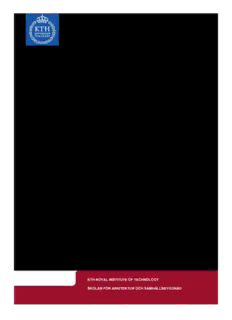
beam subjected to torsion, shear and bending PDF
Preview beam subjected to torsion, shear and bending
DEGREE PROJECT, IN STEEL STRUCTURES, SECOND LEVEL STOCKHOLM, SWEDEN 2015 Difficulties in FE-modelling of an I- beam subjected to torsion, shear and bending MIRIAM ALEXANDROU KTH ROYAL INSTITUTE OF TECHNOLOGY SKOLAN FÖR ARKITEKTUR OCH SAMHÄLLSBYGGNAD ii Difficulties in FE-modelling of an I-beam subjected to torsion, shear and bending Miriam Alexandrou June 2015 TRITA-BKN. Master thesis 464, KTH 2015 ISSN 1103-4297 ISRN KTH/BKN/B--464--SE iii ©Miriam Alexandrou 2015 Royal institute of technology (KTH) Department of Civil and Architectural engineering Division of Structural design and Bridges Stockholm, Sweden, 2015 iv ABSTRACT In this thesis six different models of IPE240 have been created in order to study their behavior under shear, bending and torsion. These models simulate IPE240 but differ in the boundary conditions, in the loading and the length of the beam and in some connections which connect certain elements. In this study the modeling and simulation of the steel member is executed in ABAQUS Finite Element Analysis software with the creation of input files. When developing a model for the finite element analysis a typical analysis process is followed. All the parameters that are required to perform the analysis are defined initially to geometry which is half the beam due to symmetry, and the material properties of each model are defined too. Then a mesh is generated for each model, the loads of each model are applied which are expressed as initial displacement. Subsequently, the boundary conditions for each model are defined and finally the model is submitted to the solver when the kind of analysis has been defined. Namely, the analysis which is performed in this thesis is static stress analysis. When the ABAQUS has run the models, the contour plots for the von Mises stresses for each model are studied. In these contour plots, a large concentration of stresses and problems which arise in each one of the models are notified. As it has been observed in all models, the beam yields at the flanges of the mid-span and collapses at the mid-span. Therefore, the failure at the mid-span is more critical than the failure at the support. Moreover, the beams are weak in bending due to the fact that they twist almost 60-90 degrees under a large initial displacement at the control node. Additionally, much localized failure and buckling occurred at the mid-span, and local concentrated stresses also occurred at the bottom flange at the support due to the boundary conditions details. Thereafter, a verification of the results of the ABAQUS through the simple analytical hand calculations is performed. It is concluded that the error appearing in most selected points is small. However, in some points in the web of the mid-span the error is greater. Additionally, while comparing the load-displacement curves of the two different plastic behaviors, it is observed that the model with an elastic-plastic with a yielding plateau slope behavior has smaller maximum load resistance than the model with a true stress-strain curve with strain hardening behavior. Finally, some errors and warning messages have occurred during the creation of the input files of the models and a way of solving them is suggested. June 2015 v vi ACKNOWLEDGEMENTS This work was carried out under the supervision of Bert Gunnar Norlin, University Lector at the KTH Royal Institute of Technology, School of Architecture and the Built Environment. I would like to express my deep gratitude to him for the help, expert instruction, guidance and support he has been providing throughout the project. Finally I will always be grateful to my family for their support throughout the course of my studies. vii viii CONTENTS ABSTRACT ................................................................................................................................ v ACKNOWLEDGEMENTS ...................................................................................................... vii LIST OF FIGURES .................................................................................................................... xi LIST OF TABLES ..................................................................................................................... xii LIST OF SYMBOLS .................................................................................................................. xii LIST OF ABBREVIATIONS .................................................................................................... xii 1. INTRODUCTION .............................................................................................................. 1 1.1. Background ................................................................................................................ 1 1.2. Scope of the study ...................................................................................................... 1 2. LITERATURE REVIEW ..................................................................................................... 3 2.1. Shear, bending and torsion ........................................................................................ 3 2.2. Stiffeners ..................................................................................................................... 5 2.3. Elastic and plastic behavior ....................................................................................... 5 2.4. FEM modeling ........................................................................................................... 7 2.4.1. Shell, beam and truss elements .......................................................................... 8 2.4.2. Multi-Point Constraints ...................................................................................... 9 3. FINITE ELEMENT MODEL DEVELOPMENT ............................................................. 11 3.1. Model definition and material properties................................................................. 11 3.2. Generated models ..................................................................................................... 14 3.3. Mesh generation ....................................................................................................... 16 3.4. Loading .................................................................................................................... 17 3.5. Boundary conditions ................................................................................................ 19 3.5.1. Mid span ........................................................................................................... 19 3.5.2. End of the beam ............................................................................................... 20 3.5.3. Load system ...................................................................................................... 21 3.6. Elastic and plastic behavior ..................................................................................... 21 3.7. Analysis .................................................................................................................... 22 4. HAND CALCULATION OF STRESSES IN THE CROSS SECTION ............................... 23 5. RESULTS AND DISCUSSION ......................................................................................... 25 ix 5.1. Problems that occurred in the finite element results ............................................... 25 5.1.1. Model 1.............................................................................................................. 25 5.1.2. Model 2 ............................................................................................................. 27 5.1.3. Model 3 ............................................................................................................. 31 5.1.4. Model 4 ............................................................................................................. 33 5.1.5. Model 5 ............................................................................................................. 35 5.2. Validation of the finite element model ..................................................................... 36 5.3. Comparison of two types of plastic behaviors .......................................................... 38 5.4. Problems and errors obtained during the generation of the input file .................... 40 4. CONCLUSIONS ............................................................................................................... 43 REFERENCES ......................................................................................................................... 45 APPENDIX A – HAND CALCULATION OF THE STRESSES IN THE CROSS SECTION ... 47 APPENDIX B – INPUT FILES FOR ALL MODELS ............................................................... 59 Model 1 ................................................................................................................................. 59 Model 2 ................................................................................................................................ 69 Model 3 ................................................................................................................................ 77 Model 4 ................................................................................................................................ 82 Model 5 ................................................................................................................................ 89 Model 6 ................................................................................................................................ 96 x
Description: